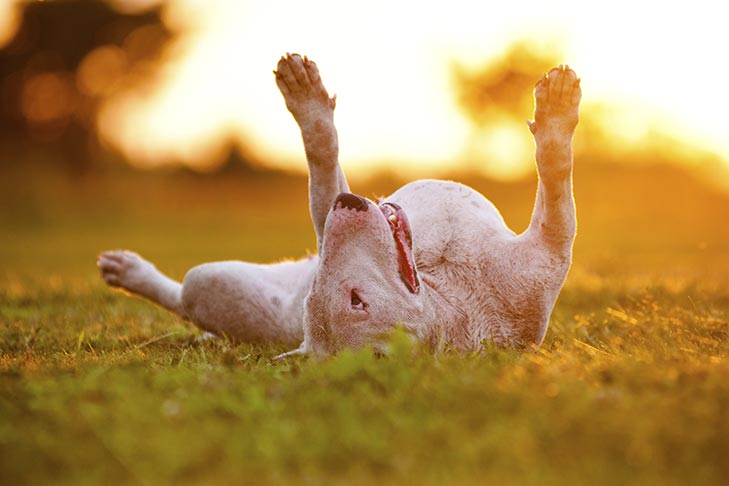Benadryl for dogs is often prescribed to treat and prevent allergic reactions, as well as motion sickness. Benadryl is also known by its generic name diphenhydramine and is among the few over-the-counter medications, which are available to dog owners. Veterinarians are regularly prescribing Benadryl to dog owners so it can easily be administered to their pets at home.
This article tries to cover everything our audience is wondering about using Benadryl for dogs at home. Important points discussed include whether Benadryl is safe for dogs, what is the dosage of Benadryl for dogs, and what are the side effects to expect when administering diphenhydramine to a dog.
According to the Merck Veterinary Manual, the safe dosage is 2-4 milligrams of medication per kilogram of weight, or 0.9 to 1.8 milligrams per pound. This amount can be administered two to three times daily, depending on your dog’s symptoms.
What Does Benadryl Treat in Dogs?
Benadryl is a great medication for use in dogs with mild-to-moderate allergies. Seasonal allergies, food allergies, environmental allergies, and allergic reactions to snake and insect bites all respond to Benadryl in most cases. Benadryl is commonly used to treat itchiness in dogs caused by skin allergies, and it also reduces many of the other symptoms of allergies, including:
One of the side effects of Benadryl is drowsiness, which helps to calm anxious dogs. The Merck Veterinary Manual states that diphenhydramine may relieve symptoms of mild-to-moderate anxiety in pets associated with travel. It also may help relieve motion sickness. Although Benadryl may sometimes relieve anxiety, it’s best to talk to your veterinarian or an animal behaviorist to determine and treat what’s causing the anxiety.
Veterinarians prescribe Benadryl for dogs with mast cell tumors to help mitigate the effects of the massive histamine release caused by mast cell degranulation. Veterinarians sometimes prescribe diphenhydramine during heartworm treatment, as it helps reduce the risk of an allergic reaction to the heartworm treatment therapy. Benadryl makes an excellent addition to your pet first aid kit.

Clubs Offering:
The temptation to reach into our medicine cabinets to treat our pets can be dangerous. Humans and dogs react very differently to medications, which is why veterinarians caution dog owners against making independent decisions about how to medicate their animals. However, some human medications are safe for use with dogs, as long as they are used appropriately.
Veterinarians use diphenhydramine, commonly known by the brand name Benadryl, for dogs on a regular basis to treat allergies, travel anxiety, and motion sickness. While you should always consult with your veterinarian before giving your dog a human medication, here is what you need to know about using Benadryl for dogs.
Benadryl is the brand name for the active ingredient diphenhydramine HCl. Diphenhydramine is a first-generation ethanolamine-derivative antihistamine, which is the scientific way of classifying antihistamines that can cross the blood-brain barrier – making them very effective but also increasing risks of adverse side effects. While Benadryl is not yet FDA-approved for veterinary use, it is considered safe for use in dogs and cats and is commonly used in veterinary practices across the U.S.
Diphenhydramine works by blocking the receptors that receive histamines in the body. This relieves many of the symptoms associated with allergies, like itching, sneezing, and hives. The body still produces histamines, but the receptor antagonist blocks the receptors from registering the histamines.
Dosage of Benadryl
As an approximate guideline, the maximum dosage of Benadryl for dogs is 1mg for every 1 pound of the dogs body weight, given 2-3 times per day, about 8-12 hours apart. Many factors can change this general guideline, so you should always talk to your vet to determine the proper dosage for your dog. In general, start with a lower dose and gradually increase it until the desired effect is reached. Some dogs are more sensitive to Benadryl than others, so starting small is best.
| Max Dose (every 8-12 hours) | Max Dose (every 8-12 hours) | |
|---|---|---|
| Dog Weight | Tablet (mg) | Childrens Liquid (ml) |
| 1 lbs – 10 lbs | 1 mg – 10 mg | 0.4 ml – 4 ml |
| 10 lbs – 20 lbs | 10 mg – 20 mg | 4 ml – 8 ml |
| 20 lbs – 30 lbs | 20 mg – 30 mg | 8 ml – 12 ml |
| 30 lbs – 40 lbs | 30 mg – 40 mg | 12 ml – 16 ml |
| 40 lbs – 50 lbs | 40 mg – 50 mg | 16 ml – 20 ml |
| 50 lbs – 60 lbs | 50 mg – 60 mg | 20 ml – 24 ml |
| 60 lbs – 70 lbs | 60 mg – 70 mg | 24 ml – 28 ml |
| 70 lbs – 80 lbs | 70 mg – 80 mg | 28 ml – 32 ml |
| 80 lbs – 90 lbs | 80 mg – 90 mg | 32 ml – 36 ml |
| 90 lb – 100 lbs | 90 mg – 100 mg | 32 ml – 36 ml |
| 100 lbs – 110 lbs | 100 mg – 110 mg | 40 ml – 44 ml |
| 110 lbs – 120 lbs | 110 mg – 120 mg | 44 ml – 48 ml |
| 120 lbs – 130 lbs | 120 mg – 130 mg | 48 ml – 52 ml |
| 130 lbs – 140 lbs | 130 mg – 140 mg | 52 ml – 56 ml |
| 140 lbs – 150 lbs | 140 mg – 150 mg | 56 ml – 60 ml |
FAQ
Can I give my dog Benadryl allergy Liqui Gels?
Do Benadryl liquid gel caps contain xylitol?